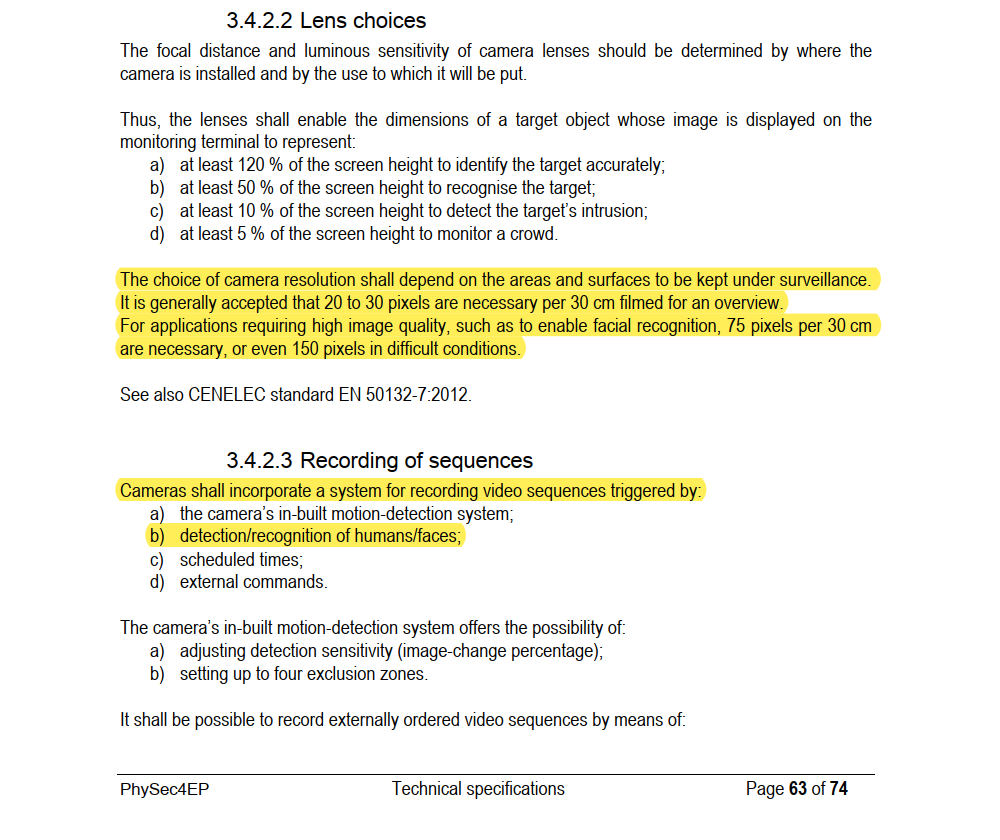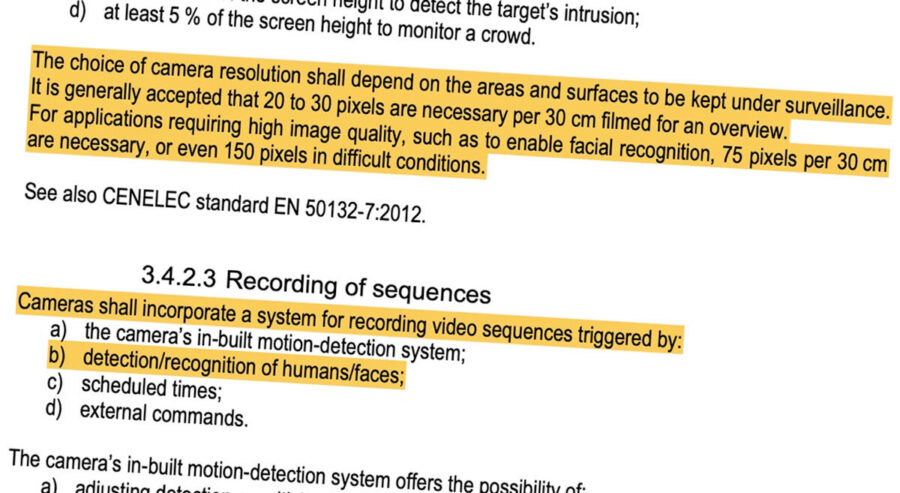16 January 2023
ICCL investigation reveals that the European Parliament requested for CCTV cameras with facial recognition capability.
ICCL has obtained 32 documents from the European Parliament about its use of CCTV cameras. We have learned that the European Parliament, which opposes facial recognition technology (FRT), had itself tendered for facial recognition capable cameras in 2015.
The European Parliament’s tender also required that all Parliament security systems should integrate with software developed by a Dutch company called Nedap, which is partnered with Chinese surveillance firm Hikvision. Hikvision is part of the systems used in China’s internment camps for Uighurs in Xinjiang.
The Parliament removed Hikvision thermal cameras premises in 2021. ICCL has written to the Parliament to ask whether other Hikvision technologies are still in use.
Dr Kris Shrishak, Technology Fellow at ICCL, said:
“It is worrying that the European Parliament tendered for facial recognition cameras. We don't yet know the purpose, or when and how often this capability has been used. Considering MEPs views on facial recognition technology in the EU’s AI Act discussions, the purchase of these cameras raise a number of questions that must be answered.”
ICCL has raised two concerns in a letter to the President of the European Parliament:
1. How long has the European Parliament used CCTVs with facial recognition capability?
2. Does the European Parliament still use Hikvision equipment?
See ICCLs related work on artificial intelligence.


Ms Roberta Metsola
President of the European Parliament
Cc.
Ms Martinez Iglesias
Director General DG SAFE
13 January 2023
CCTVs in the European Parliament
Dear Ms Metsola,
- I write on behalf of the Irish Council for Civil Liberties (ICCL), Ireland’s oldest independent human rights monitoring organisation. We have recently received documents about close-circuit television (CCTV) in operation in the European Parliament in all three locations: Brussels, Luxembourg and Strasbourg.
- We recall to your attention a 2015 tender document that specifies the Parliament’s CCTV technical requirements.[1] This raises two concerns.
How long has the European Parliament used CCTVs with facial recognition capability?
- The Parliament’s 2015 tender document includes specific requirements for facial recognition:
Cameras shall incorporate a system for recording video sequences triggered by ... detection/recognition of humans/faces [emphasis added].[2]
Additionally, the Parliament also specified the required image quality for these surveillance devices:
For applications requiring high image quality, such as to enable facial recognition, 75 pixels per 30 cm are necessary, or even 150 pixels in difficult conditions [emphasis added].[3]
- We would be grateful if you could respond to the following:
a. How long has the European Parliament used CCTV cameras with facial recognition technology capability?
b. Has the facial recognition capability been activated? If so, over what period?
c. Have the recordings from European Parliament CCTV cameras been subject to facial recognition in real-time and/or post-recording?
d. Facial recognition technologies rely on a facial database. What are the sources of facial images used by the European Parliament?
Does the European Parliament still use Hikvision equipment?
- The tender document specifies that all security systems including CCTVs should be integrated with a software platform developed by Nedap,[4] a Dutch company. Nedap currently displays the logo of the European Parliament on its website as a significant client.[5] Nedap also has a dedicated page for its technology partner: Hikvision,[6] a Chinese company that has contributed to the oppression of Uighurs in Xinjiang.[7]
- Deutsche Welle reports that the Parliament installed Hikvision thermal cameras in 2020.[8] Members of the European Parliament called out in 2021 to “remove all of Hikvision’s thermal cameras from Parliament’s premises [emphasis added]”.[9]
- Hikvision and Dahua[10] sell a range of CCTVs and surveillance products.[11] Thermal cameras are only one of them.
- We would appreciate if you could reply to the following:
a. Has the European Parliament removed all Hikvision and Dahua equipment, not just thermal cameras, from its premises?
b. Considering the proposed Directive on Corporate Sustainability Due Diligence,[12] should the security of the European Parliament continue to rely on the software platform of Nedap, a company that includes Hikvision as a technology partner? - In addition to these questions, we are concerned that facial recognition is an invasive technology that is often inaccurate and discriminatory. It turns humans into license plates. It is the perfect technology for oppression.[13]
- The European Data Protection Board and the European Data Protection Supervisor have called for a ban on the use of facial recognition technology.[14] There have also been widespread calls in the European Parliament to prohibit facial recognition technology.[15]
Dr Kris Shrishak
Technology Fellow, ICCL
Notes
[1] Invitation to tender, Open procedure EP/DGSAFE/UTSI/FOUR/2015-015 - Technical specifications. 12 October 2022. URL: https://www.europarl.europa.eu/RegData/publications/divers/2022/1025/EP-PE_DV(2022)1025(2015-02-03)_XL.pdf
[2] Ibid., p. 63.
[3] Ibid., p. 63.
[4] Ibid., pp. 5-6.
[5] Nedap, AEOS access control. URL: https://www.nedapsecurity.com/solutions/aeos-access-control/ Archive: https://web.archive.org/web/20221129034120/https://www.nedapsecurity.com/solutions/aeos-access-control/
[6] Nedap, Technology partner - Hikvision. URL: https://www.nedapsecurity.com/technology-partner/hikvision/
[7] Amnesty International, China: ‘Crimes against humanity’ being committed in Xinjiang, 10 June 2021. URL: https://www.amnesty.org.uk/press-releases/china-crimes-against-humanity-being-committed-xinjiang-new-report; IPVM, Video Reveals Hikvision Cameras Surveilling Xinjiang Concentration Camps, 29 November 2021. URL: https://ipvm.com/reports/hik-video-xinjiang.html
[8] Deutsche Welle, EU taps Chinese tech linked to Muslim internment camps. 26 October 2020. URL: https://www.dw.com/en/exclusive-eu-taps-chinese-technology-linked-to-muslim-internment-camps-in-xinjiang/a-55362125
[9] 2019 discharge: EU general budget - European Parliament. Paragraph 73. 29 April 2021. URL: https://www.europarl.europa.eu/doceo/document/TA-9-2021-0165_EN.html
[10] DR. YANG Jianli’s Presentation at PUBLIC HEARING "Authoritarianism and shrinking space for freedom of expression, press freedom and human rights defenders, with case studies on China, Egypt and Russia." 18 February 2020. URL: https://www.europarl.europa.eu/cmsdata/197880/Speech+remarks%20for%20publication_Jianli%20YANG.pdf
[11] See for example Hikvision’s product range: https://www.hikvision.com/content/dam/hikvision/en/brochures-download/product-family-tree/CCTV%20Products%20Family%20Tree.pdf
[12] Proposal for a Directive of the European Parliament and of the Council on Corporate Sustainability Due Diligence and amending Directive (EU) 2019/1937 Corporate Sustainability Due Diligence, 23 February 2022. URL: https://eur-lex.europa.eu/legal-content/EN/TXT/?uri=CELEX%3A52022PC0071
[13] Woodrow Hartzog, Facial Recognition Is the Perfect Tool for Oppression. 2 August 2018. URL: https://cyberlaw.stanford.edu/publications/facial-recognition-perfect-tool-oppression
[14] EDPB & EDPS call for ban on use of AI for automated recognition of human features in publicly accessible spaces, and some other uses of AI that can lead to unfair discrimination. 21 June 2021. URL: https://edpb.europa.eu/news/news/2021/edpb-edps-call-ban-use-ai-automated-recognition-human-features-publicly-accessible_en
[15] Euractiv, AI Act: EU Parliament’s discussions heat up over facial recognition, scope. 6 October 2022. URL: https://www.euractiv.com/section/digital/news/ai-act-eu-parliaments-discussions-heat-up-over-facial-recognition-scope/
